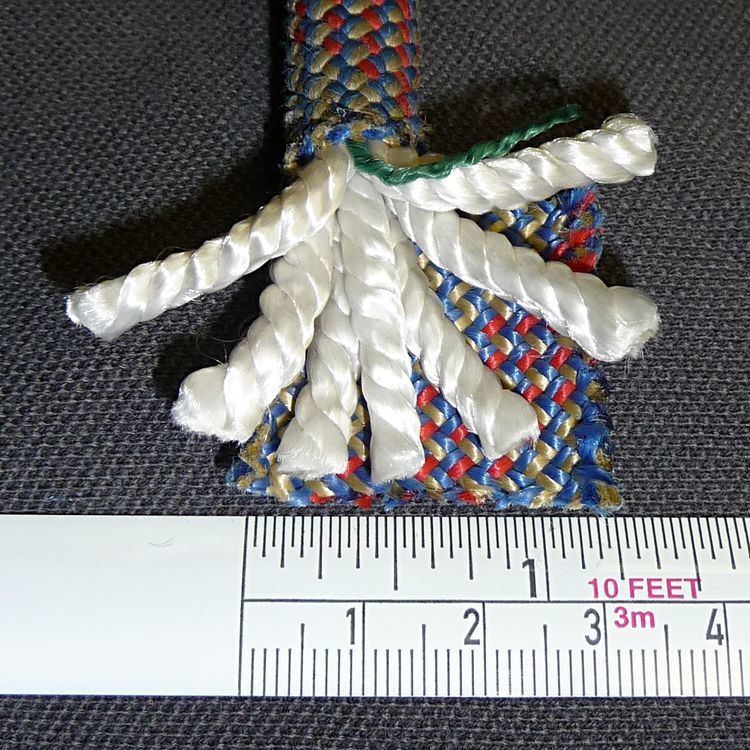 | ||
Kernmantle rope is rope constructed with its interior core (the kern) protected by a woven exterior sheath (mantle) designed to optimize strength, durability, and flexibility. The core fibers provide the tensile strength of the rope, while the sheath protects the core from abrasion during use. The name is derived from the German words Kern and Mantel, which mean core and jacket.
Contents
Parachute cord
Parachute cord (also paracord or 550 cord when referring to type-III paracord) is a lightweight nylon kernmantle rope originally used in the suspension lines of parachutes. This cord is useful for many other tasks and is now used as a general purpose utility cord by both military personnel and civilians.
Use as climbing rope
Nylon ropes that were used in yachts for hauling were tested and found useful in climbing and caving and are now the modern standard. The German company Edelrid introduced the first kernmantel rope in 1953, which revolutionized fall prevention. Hemp climbing rope became a thing of the past and rope breakage was greatly reduced. In 1964, Edelrid developed a dynamic rope capable of withstanding multiple falls. It became the forerunner of the modern dynamic climbing rope. Although there were occasional innovations, the rope used today is similar in construction, strength, and durability across manufacturers. There are several major manufacturers, including Pigeon Mountain Industries (PMI), which is popular with cavers, Mammut, Sterling, Beal, Edelweiss, Blue Water, Roca, Tendon and Maxim. Overall there is a huge variety of climbing ropes available for different purposes; for instance, there are well over one hundred different dynamic single ropes (the most popular rope system in climbing). Kernmantle ropes are still used in sailing and other sports, but the technical requirements are usually not as rigorous for such purposes as for climbing, since those applications are not as critical to safety. Small kernmantle ropes are commonly called accessory cords; they are often used to make prusik knots and loops or to attach accessories such as chalk bags.
One or more of the rope characteristics (strength, durability, and flexibility) is often altered, depending upon the ultimate use of the rope, at the expense of the other properties. For example, rope used in caving is generally exposed to increased abrasion, so the mantle is woven more tightly than rope used in climbing or rappelling. However, the resulting rope is cumbersome and difficult to tie knots in.
Kernmantle construction may be used for both static and dynamic ropes. Static ropes are designed to allow relatively little stretch, which is most useful for applications such as hauling and rappelling. Dynamic rope is used to belay climbers, and is designed to stretch under a heavy load to absorb the shock of a fallen climber. Dynamic ropes manufactured for climbing are tested by the UIAA. A test of "single" standard rope involves tying an 80 kg (176 pound) weight to the end of a length of rope. This weight is then dropped 5 meters (16½ feet) on 2.7 meters (9 feet) of rope, with the rope running over a rounded surface simulating that of a standard carabiner. This process is repeated until the rope breaks. For "double" ropes the weight is 55 kg, and for twin ropes two strands are used. In addition to the number of drops, the impact force is also measured. It is a common misunderstanding to think that the number of drop test falls (as conducted by the UIAA) is the number of real-life climbing falls a rope can sustain before it becomes unsafe. The drop test falls are of extreme severity and a real-life climbing fall will not often generate a comparable force. This adds a margin of safety for climbers who use such ropes.
Rope care
Kernmantle rope should be inspected before and after every use for any form of damage. "Boogers," which indicate internal damage to the kern, appear as tufts of white threads poking out from the mantle. Ropes that have been severely stressed have tapered sections which are visibly or palpably thinner. Rope that has been abraded or cut on sharp edges should be examined closely by an experienced user, who may choose to cut the rope at that point, rather than risk it parting at that location.
A rope may be cleaned by forming it into a chain sinnet to prevent excessive tangling and washing it in a front-loading clothes washing machine with soap flakes. Strong cleansers, including bleach and detergent should not be used on life-critical nylon components. Commercial rope cleaning devices are also available.
Typical specifications
*Dynamic ropes are rated for a certain number of falls (usually 5-10) at a given impact force.
